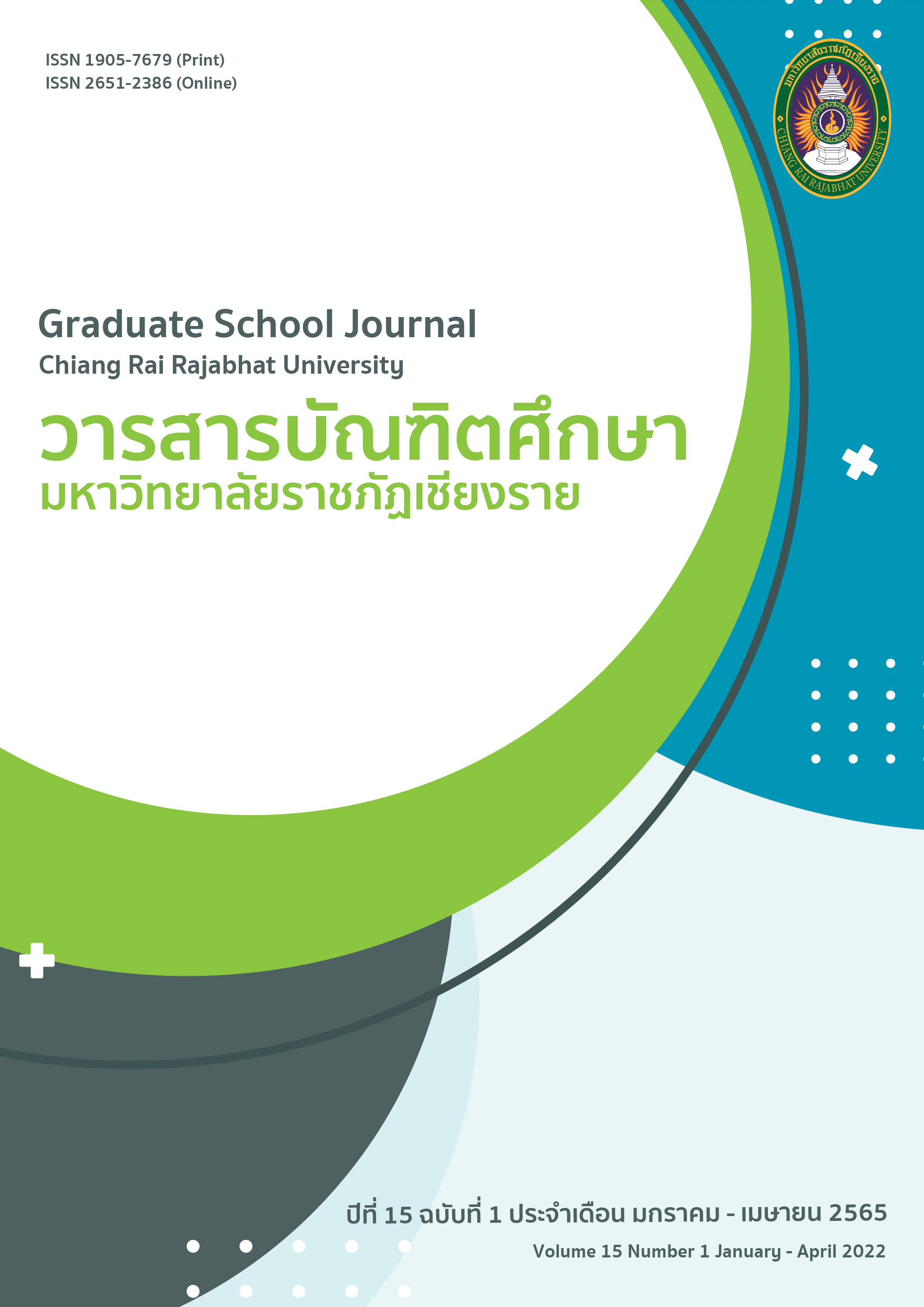ผลการจัดกิจกรรมการเรียนรู้โดยใช้ปัญหาเป็นฐานที่มีต่อผลสัมฤทธิ์ทางการเรียนคณิตศาสตร์และความสามารถในการแก้ปัญหาทางคณิตศาสตร์ เรื่อง พีระมิด กรวย และทรงกลม ของนักเรียน ชั้นมัธยมศึกษาปีที่ 3 โรงเรียนคำยางพิทยา จังหวัดอุดรธานี
Main Article Content
บทคัดย่อ
การวิจัยครั้งนี้มีวัตถุประสงค์เพื่อ 1) ศึกษาความสัมพันธ์ระหว่างผลสัมฤทธิ์ทางการเรียนคณิตศาสตร์และความสามารถในการแก้ปัญหาทางคณิตศาสตร์ของนักเรียนชั้นมัธยมศึกษาปีที่ 3 กลุ่มที่ได้รับการจัดกิจกรรมการเรียนรู้โดยใช้ปัญหาเป็นฐานและ 2) เปรียบเทียบผลสัมฤทธิ์ทางการเรียนคณิตศาสตร์และความสามารถ ในการแก้ปัญหาทางคณิตศาสตร์ของนักเรียนชั้นมัธยมศึกษาปีที่ 3 ระหว่างกลุ่มที่ได้รับการจัดกิจกรรมการเรียนรู้โดยใช้ปัญหาเป็นฐานกับกลุ่มที่ได้รับการจัดการเรียนรู้แบบปกติ
กลุ่มตัวอย่างที่ใช้ในการวิจัย คือ นักเรียนชั้นมัธยมศึกษาปีที่ 3 โรงเรียนคำยางพิทยา จังหวัดอุดรธานี ภาคเรียนที่ 2 ปีการศึกษา 2563 จำนวน 2 ห้อง มีนักเรียนห้องละ 24 คน ได้มาโดยการสุ่มแบบกลุ่ม เครื่องมือที่ใช้ในการวิจัยประกอบด้วย 1) แผนการจัดกิจกรรมการเรียนรู้โดยใช้ปัญหาเป็นฐาน เรื่อง พีระมิด กรวย และทรงกลม 2) แผนการจัดการเรียนรู้แบบปกติ เรื่อง พีระมิด กรวย และทรงกลม 3) แบบวัดความสามารถในการแก้ปัญหาทางคณิตศาสตร์ เรื่อง พีระมิด กรวย และทรงกลม และ 4) แบบทดสอบผลสัมฤทธิ์ทางการเรียนวิชาคณิตศาสตร์ เรื่อง พีระมิด กรวย และทรงกลม สถิติที่ใช้ในการวิเคราะห์ข้อมูล ได้แก่ ค่าเฉลี่ย ส่วนเบี่ยงเบนมาตรฐาน สัมประสิทธิ์สหสัมพันธ์แบบเพียร์สัน และสถิติทดสอบ MANOVA
ผลการวิจัยพบว่า 1) ความสัมพันธ์ระหว่างผลสัมฤทธิ์ทางการเรียนคณิตศาสตร์และความสามารถในการแก้ปัญหาทางคณิตศาสตร์ของนักเรียนชั้นมัธยมศึกษาปีที่ 3 กลุ่มที่ได้รับการจัดกิจกรรมการเรียนรู้โดยใช้ปัญหาเป็นฐานมีความสัมพันธ์ทางบวก ขนาดความสัมพันธ์สูงมาก (r = 0.891, p < .05) และมีนัยสำคัญทางสถิติที่ระดับ .05 โดยมีความแปรปรวนร่วมกันร้อยละ 79.38 2) ผลสัมฤทธิ์ทางการเรียนคณิตศาสตร์และความสามารถในการแก้ปัญหาทางคณิตศาสตร์ของนักเรียนชั้นมัธยมศึกษาปีที่ 3 กลุ่มที่ได้รับการจัดกิจกรรมการเรียนรู้โดยใช้ปัญหาเป็นฐานสูงกว่ากลุ่มที่ได้รับการจัดกิจกรรมการเรียนรู้แบบปกติอย่างมีนัยสำคัญทางสถิติที่ระดับ .05
Article Details

อนุญาตภายใต้เงื่อนไข Creative Commons Attribution-NonCommercial-NoDerivatives 4.0 International License.
บทความที่ได้รับการตีพิมพ์เป็นลิขสิทธิ์ของวารสารมหาวิทยาลัยราชภัฎเชียงราย
ข้อความที่ปรากฏในบทความแต่ละเรื่องในวารสารวิชาการเล่มนี้เป็นความคิดเห็นส่วนตัวของผู้เขียนแต่ละท่านไม่เกี่ยวข้องกับมหาวิทยาลัยราชภัฎเชียงราย และคณาจารย์ท่านอื่นๆในมหาวิทยาลัยฯ แต่อย่างใด ความรับผิดชอบองค์ประกอบทั้งหมดของบทความแต่ละเรื่องเป็นของผู้เขียนแต่ละท่าน หากมีความผิดพลาดใดๆ ผู้เขียนแต่ละท่านจะรับผิดชอบบทความของตนเองแต่ผู้เดียว
เอกสารอ้างอิง
เทศบาลนครยะลา. (2562). สภาพทั่วไปและข้อมูลพื้นฐานของเทศบาลนครยะลา. สืบค้นเมื่อ 23 มกราคม 2563, จาก http://www.yalacity.go.th/static/general
บุญชม ศรีสะอาด. (2554). การวิจัยเบื้องต้น. กรุงเทพฯ: สุวีริยาสาส์น.
พงษ์ศักดิ์ ยิ่งชนม์เจริญ. (2558). เมืองยะลากับแนวคิดการจัดการเมือง. กรุงเทพฯ: ศูนย์ศึกษามหานครและเมือง มหาวิทยาลัยรังสิต.
พวงเพชร์ ธนะสิน. (2552). การเสริมสร้างภูมิทัศน์ในเทศบาลนครเชียงใหม่. เชียงใหม่: ภาควิชาภูมิศาสตร์ คณะสังคมศาสตร์ มหาวิทยาลัยเชียงใหม่.
สกลรัชต์ คงรอด และ อัญญาณี อดทน. (2561). ศึกษาความพึงพอใจในการใชบริการสวนสาธารณะในเขตเทศบาลนครเมืองอุบลราชธานี. วารสารราชธานีนวัตกรรมทางสังคมศาสตร์, 2(1), 53-62.
สรียา หมัดอาด้ำ. (2561). กิจกรรมและความต้องการใช้ประโยชน์สวนสาธารณะของประชาชนในเขตเทศบาลนครยะลา. (ปริญญานิพนธ์ศิลปศาสตรมหาบัณฑิต). มหาวิทยาลัยทักษิณ. สงขลา.
สำนักงานนโยบายและแผนทรัพยากรธรรมชาติและสิ่งแวดล้อม. (2560). แนวทางการจัดการพื้นที่สีเขียวสำหรับชุมชนเมืองในประเทศไทย. กรุงเทพฯ: สำนักงานฯ.
เสน่ห์ ญาณสาร. (2549). ภูมิศาสตร์เมือง. เชียงใหม่: ภาควิชาภูมิศาสตร์ คณะสังคมศาสตร์ มหาวิทยาลัยเชียงใหม่.
อัจฉรา กุดวงศา. (2551). ความพึงพอใจของผู้ใช้บริการต่อการจัดสภาพแวดล้อมของสวนสาธารณะกรณีศึกษา : สวนเฉลิมพระเกียรติสมเด็จพระนางเจ้าสิริกิติ์พระบรมราชินีนาถจังหวัดมหาสารคาม. (ปริญญานิพนธ์วิทยาศาสตรมหาบัณฑิต). มหาวิทยาลัยมหาสารคาม. มหาสารคาม.
อุบลรัตน์ หยาใส่ และ จิราภรณ์ ตั้งกิตติภาภรณ์. (2557). แนวทางการพัฒนาพื้นที่สีเขียวอย่างยั่งยืนในเขตเทศบาลนครเชียงใหม่. วารสารการพัฒนาชุมชนและคุณภาพชีวิต, 2(3), 233-243.
Sauer, C. O. (1974). The Morphology of Landscape. in J. Leighly (ed.). Land and life. Berkeley, California: University of California Press.
Wolch, J.R., Byrne, J. and Newell, J.P. (2014). Urban green space, public health, and environmental justice : The challenge of making cities Just green enough. Landscape and Urban Planning, 125(1), 234–244.


